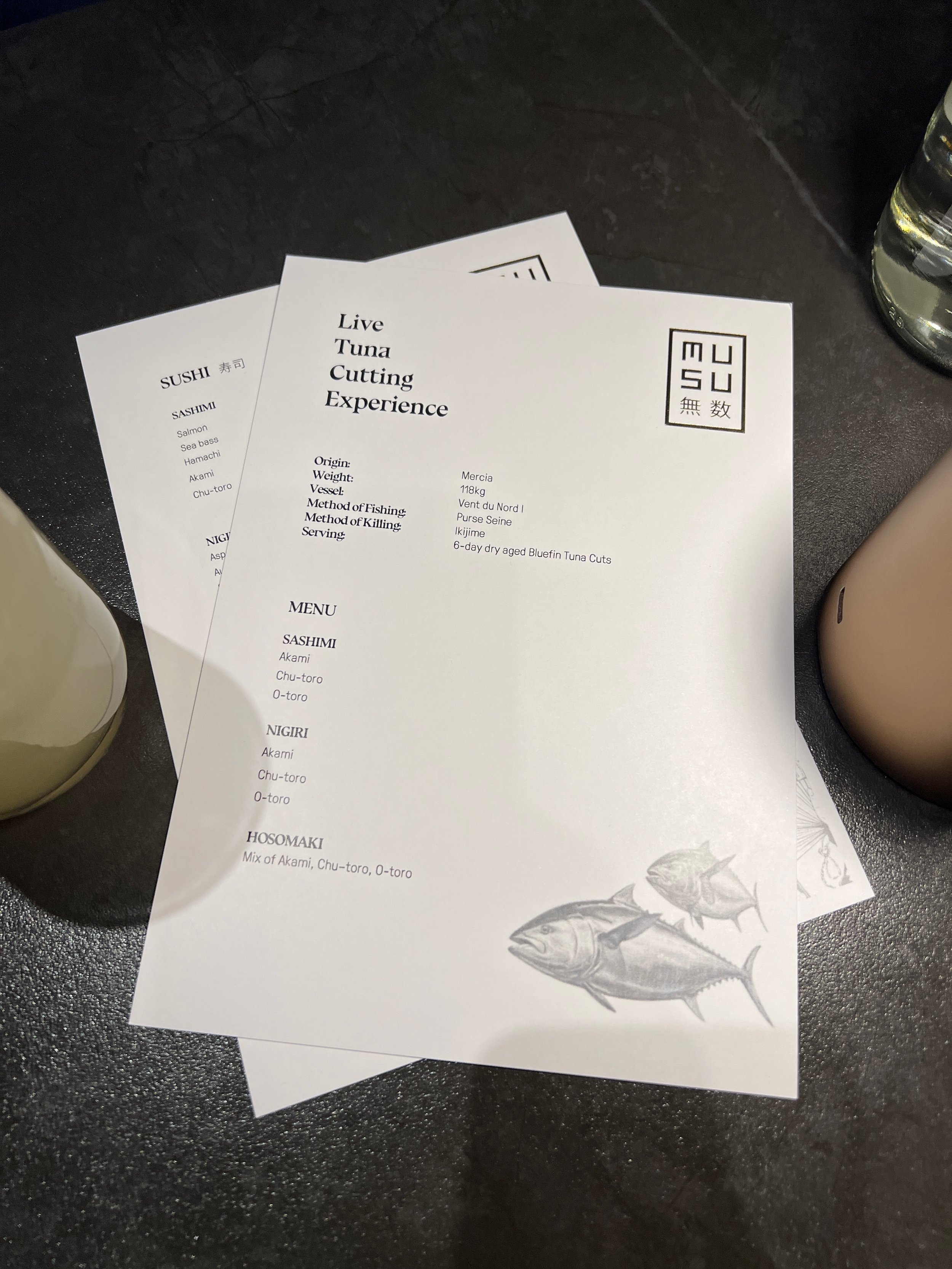Unveiling the Art of Tuna at MUSU, Manchester
Last night, we had the thrill of stumbling upon a unique tuna-cutting event at MUSU in Manchester. (Yes, I had never heard of a tuna-cutting event before, but as soon as I saw the ad on Instagram, I was instantly captivated and had to book it!)
The experience was truly sensory, watching the skilled staff break down a 120kg tuna right before our eyes and getting to savor the freshest Tuna possible, right off the bone! The taste was unparalleled, a testament to the quality of the food.
The evening started with snacks and a welcome drink and then kicked off with a 60-minute demonstration of how the restaurant breaks down a whole tuna. Chef Mike Shaw explained how he sources his fish where this tuna came from and how it is killed and transported to the restaurant.
As his team got to work butchering the fish in front of us, Mike explained all the different sections of the fish, what they are used for and how he ages and prepares them for service.
We learned a lot at this event, and it really made us appreciate the amount of effort and skill that goes into preparing those delicious bits of sushi that we love.
Our bluefin tuna
A Journey Through Tuna
Our bluefin tuna (which we nicknamed Stan) came from a farm in Mercia, Sapin and weighed 118kg making it around 18 months old.
It was killed immediately after capture using a Japanese method called Ikijime, which involves striking the tuna with a sharp spear straight into the back of its head. This results in an instant, pain-free kill and preserves the meat quality as this method doesn’t lead to blood from wounds being leached into the flesh.
Once the fish has been gutted and cleaned, it is transported to the restaurant on ice to keep it fresh.
One intriguing aspect I discovered during this experience was that even when served raw, tuna is not immediately presented. We had the opportunity to taste some fresh fish, which had a distinct metallic taste. This is why the tuna is typically dry-aged for a span of 5-7 days before it is served at the restaurant.
This ageing process allows the flavour to mature and develop, resulting in a more nuanced and enjoyable dining experience.
Breaking down the whole tuna
Mike’s team proceeded to break down the entire tuna into its main parts:
The head - used for stocks and sauces
The collar meat - The prized possession served as part of the Omakase menu
The tail - used for stocks and sauces
The back loin (2 pieces) - Lean meat
The belly loin (2 pieces) - Fattier meat
The carcass - Used for stocks and sauces, and meat is scrapped off for maki rolls
From here, the team can prepare the meats into blocks of clean flesh for sashimi and nigiri cuts.
With any restaurant needing to remain profitable, no part of the tuna is wasted (it cost him £3000). Any trimmings are stored and chopped up for maki rolls and tartare.
A guide to the different cuts of Tuna
As mentioned earlier, the collar is the most prized part of the tuna since you only get a small amount of it and Chef Mike saves this for his Omakase guests.
After that, there are three main kinds of tuna cuts that he prepares:
Akami: The lean, red meat with no fat offers a clean taste.
Chu-toro: Semi-fatty and slightly richer, a perfect balance of flavour.
O-toro: Fatty and beautifully marbled, which melts in your mouth.
Subsequent research has shown me that there are many more different subcategories of tuna cuts which we will write about in more detail in a later post.
Akami on the left, Chu-toro in the middle and O-toro on the right
Akami on the left, Chu-toro in the middle and O-toro on the right
What we ate during the evening
At the start of the evening, we were served some canapes of salmon and crab (the crab was outstanding!)
During the demonstration, we were given a taste of the tuna meat straight from the cutting, which included a slice of prepared Akami and the flesh from the carcass.
After the demonstration, we returned to our tables and were given a 3-course menu which included:
Sashmi of Akami, Chutoro and Otoro (2 slices each)
Nigiri of Akami, Chutoro and Otoro (1 each)
Hosomaki of mixed tuna (2 each)
(the tuna served here had been dry-aged for six days, not from the freshly cut one)
We had two carafes of Saki to accompany the meal, and afterwards, we ordered some extra sushi from the menu, including the Hamachi, which was excellent. We did try to order more sushi as we were still hungry, but the kitchen had closed (it was 21:15).
Our thoughts on the evening
The Tuna cutting itself was informative and enjoyable, and Chef Mike did an excellent job of explaining the process we did leave with a much better understanding and appreciation of tuna and sushi in general.
The quality of the sushi we were served was outstanding as well (proper sushi with wasabi inside and the fish glazed).
The main downside of the evening was that we still left hungry. Having paid £80 for a ticket to order more sushi on top and still wanting more is a bit of a shame. We spent about £150 each by the end and grabbed a kebab to share before retiring to our hotel.
Would we do it again? … Absolutely.









